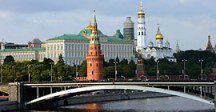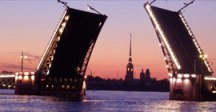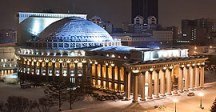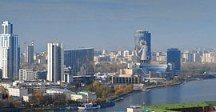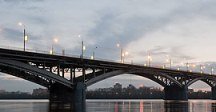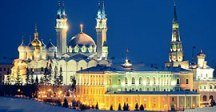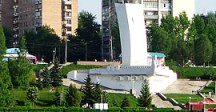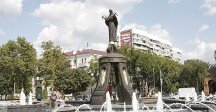Map of Penza
Detailed interactive map of Penza. Map of Penza with streets and numbers of houses. Satellite map of Penza with sights of the city.
The change between the satellite map of Penza and the schematic one is made in the lower left corner of the interactive map.
Penza
Penza population: 516,450 people (2021)
Date of foundation Penza: 1663
Penza city phone code: +7 8412
Penza automobile area code: 58, 158
Postal code of Penza: 4400xx
Penza is a settlement on the Volga upland, which stretches on the banks of the Sura River. This is a very old town, which had its own urban status back in 1661.
The oldest quarter of the city, which appeared almost at the same time as the city itself, is Moskovskaya Street, which today is pedestrian. It is on it that the most valuable city monuments are located. These include the Philharmonic Hall, the Drama Regional Theater, and the Meat Passage.
Modern monuments include a cuckoo clock, by which the townspeople check the time, as well as a light and music fountain. Since the life of Yemelyan Pugachev is connected with Penza, one of the main monuments of Penza, the Pugachev memorial stone, can be seen in the city center.
What to see in Penza
Penza's main war memorial is located on Victory Square on Victory Avenue. The monument depicts a soldier next to a woman holding a small child in her arms, who, in turn, holds a branch high. The eternal flame is also included in the memorial. Further along Pobedy Avenue there is a monument with a Mig aircraft taking off and a monument to Penza soldiers who fell in the Chechen War, which has the shape of an opening star.
Immediately behind the war memorial stands the chapel of Archangel Michael, which was consecrated in 2000 and in which a special service for all those who died in the war in Penza took place soon after. It was built in the ancient square-cross Russian style of church architecture with barrel vaults and topped with a single dome.
On the territory of the former Penza Noble Institute there is a museum dedicated to Ilya Ulyanov, who worked here from 1855 to 1863 as a teacher of physics and mathematics. Ilya Ulyanov was not only a famous teacher and school inspector, but also the father of Vladimir Lenin.
The museum has four halls dedicated to the social and educational life of Penza in the 19th century. The monument to Ilya Ulyanov and his wife Maria (Lenin's parents) was unveiled at the Institute building in 1969.
The Penza Art Gallery was opened in 1891 and now bears the name of the artist Konstantin Savitsky, who died in Penza in 1905. The gallery's collection includes works of art from Western Europe and Russia. In addition, it has three memorial halls dedicated to Konstantin Savitsky, Ivan Goryushkin-Sorokopudov and Aristarchus Lentulov. All three artists have connections with Penza or the Penza region, and their works are exhibited in the gallery.
The Penza Regional Museum of Local Lore on Krasnaya Street consists of seven halls, which feature expositions dedicated to the history, culture and nature of Penza and the Penza region. The museum presents exhibitions dedicated to the ancient settlements of the region, the founding of the city, civil life in the city during the imperial period and the military history of Penza. The exhibition also features fossils, including a giant mammoth skeleton, and stuffed animals that can be found in the Penza region.
The Penza Planetarium in Belinsky Central Park was built in 1928 as an observatory, and then equipped as a planetarium in 1954. It was originally dedicated to Ilya Ulyanov (Lenin's father), who worked on a project in Penza to observe the Earth's atmosphere in 1855. The wooden building of the planetarium is now protected by the state. There is a statue of Vladimir Lenin outside.
Mikhail Lermontov Gardens are located between Karl Marx and Lermontov Streets on the so-called Sovetskaya Square. The gardens are located in the southern part of the square and, of course, are decorated with a bust of the great Russian writer. Originally, the square was called Cathedral Square, since the Spassky Cathedral was located here.
A cuckoo clock. Another attraction of Penza can be found in the park next to Moskovskaya Street, which runs parallel to Kirov Street. The clock was installed in 1974 and immediately became popular among the locals. The inspiration for the creation of the monument was a watch that was once produced at the famous watch factory in Serdobsk, Penza region.
All that remains of the fortress, which marked the birth of the city of Penza, are its mounds, and in 1980 a memorial and historical complex was opened here. The main feature is the monument to the First Settler, which depicts a settler in ancient Russian clothes standing next to a stallion. At the base of the monument there is an inscription quoting the first written mention of Penza: “In 1663, it was ordered to build a city on the Penza River.”
Pokrovsky Cathedral on Chkalov Street. Previously, there was a wooden church dedicated to the Intercession of the Virgin Mary, where Russian dragoons were stationed to protect the city, on the site of the Old Dragoon settlement. In 1765, the stone cathedral was built in the Baroque style.
The museum of one painting on Kirov Street is unique for the reason that it exhibits only one painting. The idea of the museum is to better introduce people to the masterpieces of Russian culture by showing a slide film with additional background information about the era in which the painting was painted and about the artist who painted it.
There is a monument on the banks of the Sura River, which has become the hallmark of Penza. It is known as the Sprout Monument, as the monument resembles a shoot emerging from the ground. It is dedicated to the military and labor exploits of the people. Letters to future generations were immured inside the granite slab of the monument.
The Transfiguration Church was built between 1735 and 1750, originally as the cathedral of the Transfiguration Monastery. However, the location of the monastery turned out to be unsuitable, and therefore in 1794 the monastery was moved to a new location, and its cathedral was transformed into a parish church.
The only convent in Penza is the Trinity Convent, which was founded between 1689 and 1692, but closed between 1927 and 1994. Now two monastic churches have been preserved, surrounded by a monastic wall. The older of the two churches is the Church of the Holy Spirit, although due to recent renovation it now looks newer than its younger neighbor.
Monument to Vissarion Belinsky. The great Russian literary critic Vissarion Belinsky lived in Chembar, Penza region, which was later renamed in his honor, and from 1825 to 1829 studied at Penza Classical Gymnasium No. 1, which now also bears his name. This monument was opened in 1954 on the Theater Square opposite the Lunacharovsky Drama Theater.
As in almost all Russian cities, Penza has its own statue of Vladimir Lenin. The monument in Penza was opened in 1959 in front of the Penza Region administration building. The monument rises six meters, including the pedestal, and depicts Lenin in a long coat with his hand in his pocket.
The Penza Museum of Folk Art on Kuibyshev Street is located in a beautifully decorated building that looks like a fairy tale and is one of the most famous sights of Penza. The purpose of the museum is to teach people folk applied arts and crafts in order to preserve traditions. The museum displays examples of woodcarving, carpet weaving, ceramics, glass and handmade knitwear.
The Church of St. Mitrofan of Voronezh was consecrated in 1836. It is located at the Mitrofanovsky cemetery, where several of the most famous citizens of Penza are buried, including artists Konstantin Savitsky and Ivan Goryushkin-Sorokoprudin. The church houses the most revered relic of Penza - a copy of the icon of the Kazan Mother of God. According to legend, the icon was presented to the city at its foundation by Tsar Alexy and answered the prayers of the townspeople for their protection from the Kuban pogrom.
There is an Afghan War Memorial in front of the Sura Aquatics Palace on Marshal Zhukov Square. The memorial complex was opened in 2010 and includes an eternal flame and an arch decorated with eight bronze reliefs. To the side there are plates with the names of soldiers from Penza who died during the conflict.
The red brick Assumption Diocesan Cathedral on Zakharova Street was built in 1905 on top of a hill, making its five black domes visible from most of the city. The cathedral houses the relics of St. Innocent of Penza, who became the first saint of Penza in 2000.
Monument to Vasily Klyuchevsky on Plekhanov Street. Along with Nikolai Karamzin and Sergei Solovyov, Vasily Klyuchevsky is considered one of the most authoritative Russian historians. He was born in Penza province in 1841. This monument to him was unveiled in 2008 and became the first monument in history dedicated to an outstanding Russian historian.
Vsevolod Meyerhold House Museum and Theater Center on Volodarsky Street. The great theater actor, director and producer Vsevolod Meyerhold was born in Penza. The house where the Meyerhold family lived was turned into a memorial museum dedicated to Meyerhold in 1984.
Penza sights
The monument "Pioneer Settler", the K.A.Savitsky Art Gallery, the Meyerhold Museum, the Zoya Kosmodemyanskaya Dollhouse, the Penza Regional Drama Theater named after A.V. Lunacharsky, the Museum of Local Lore, the Museum of One Painting, the Zolotarevskoye Settlement Museum, the V.G. Belinsky Park, the Zoo, the Penza Trinity Convent, the Mitrofan Voronezh Church, Assumption Cathedral, Museum of one painting named after G.V. Myasnikova, Monument "Globe", Monument of Military and Labor Glory, Dr. Dapertutto Theater, Spassky Cathedral, Penza Planetarium, Penza Museum of Folk Art, Governor's House, Penza Cathedral Mosque, Meyerhold House, Penza Botanical Garden.
The largest cities in Russia:
2024 © Russia-Karta.ru
